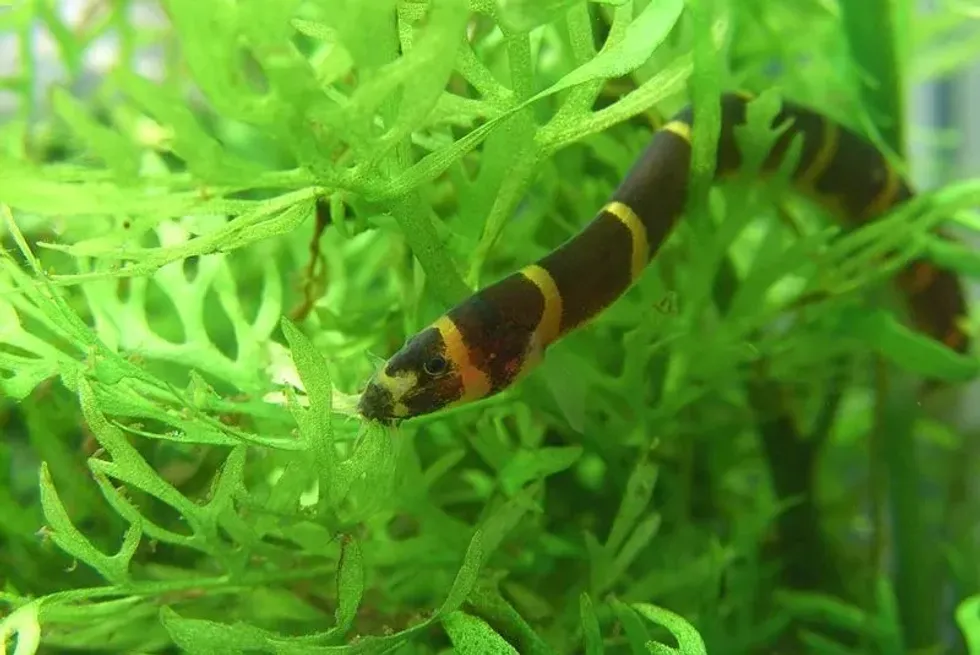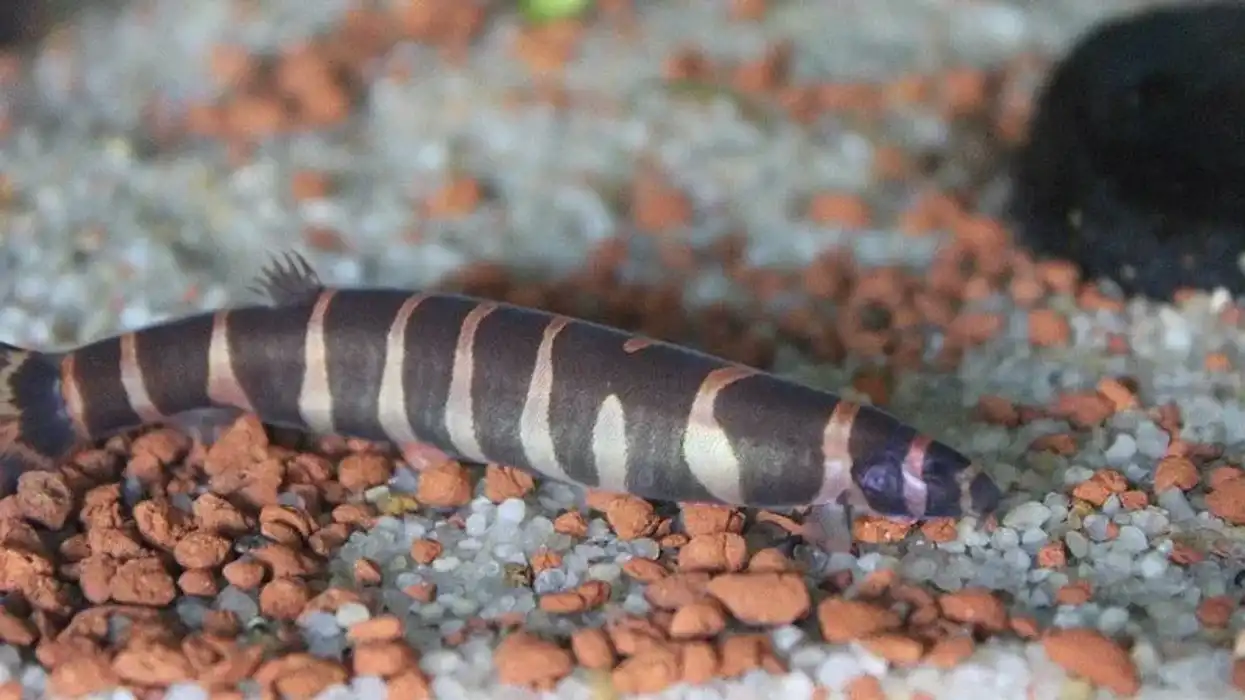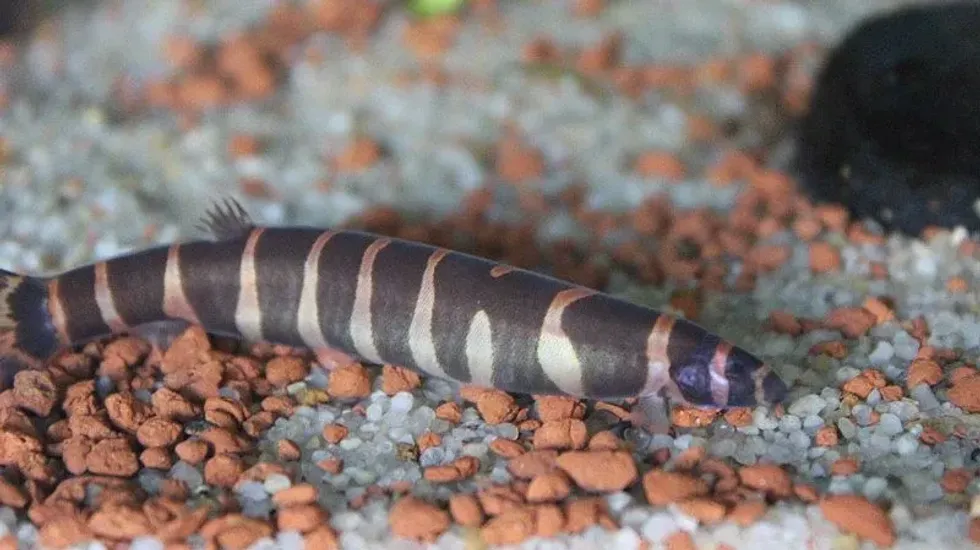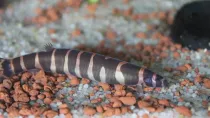Fun Kuhli Loach Facts For Kids

Content
- What type of animal is a Kuhli Loach?
- What class of animal does a Kuhli Loach belong to?
- How many Kuhli Loaches are there in the world?
- Where does a Kuhli Loach live?
- What is a Kuhli Loach's habitat?
- Who do Kuhli Loaches live with?
- How long does a Kuhli Loach live?
- How do they reproduce?
- What is their conservation status?
- What do Kuhli Loaches look like?
- How cute are they?
- How do they communicate?
- How big is a Kuhli Loach?
- How fast can a Kuhli Loach swim?
- How much does a Kuhli Loach weigh?
- What are the male and female names of the species?
- What would you call a baby Kuhli Loach?
- What do they eat?
- Are they dangerous?
- Would they make a good pet?
- Did you know...
- Do people eat Kuhli Loach?
- Taking Care Of A Kuhli Loach
Have you ever spotted a yellow and black striped eel-like fish in a community tank or an aquarium? If yes, then it might have been a Kuhli loach.
It is a freshwater fish that originates in the slow streams or rivers of Indonesia and the Malay peninsula. Currently, it's commonly found in aquariums or tank fishes because of its colorful appearance.
It's a bottom-feeding fish, and it loves to snack on live foods such as bloodworms. You will often find it swimming at the bottom of an aquarium or hiding in some corner of the tank. One of the interesting things about the Kuhli loach is its green eggs that look beautiful.
It is also reasonably easy to take care of the Kuhli loach in a fish tank, and it has no fuss over any kind of food. It likes to have plants around them, and the fish looks even cuter when it peeks from the foliage.
Want to know more Kuhli Loach facts? Keep reading to learn more about them!
Also, check out the articles on tarpon and beluga sturgeon to know more about water animals.
Kuhli Loach Interesting Facts
What type of animal is a Kuhli Loach?
The Kuhli loach is a type of eel-like fish that is mostly kept as an aquarium fish.
What class of animal does a Kuhli Loach belong to?
The Kuhli loach belongs to the class Actinopterygii and the genus Pangio which is for specifying true loach species.
How many Kuhli Loaches are there in the world?
As an extensively found aquarium fish species, it is hard to put an exact figure to the total population of Kuhli loaches present in this world.
Where does a Kuhli Loach live?
In its native habitat of Indonesia or the Malay peninsula, the Kulhi loaches live in freshwater bodies like slow-flowing rivers, lakes, and clean mountain streams. Currently, the species is more commonly seen as an aquarium fish all over the world.
What is a Kuhli Loach's habitat?
The Kuhli loach likes to inhabit tropical waters where the temperature is around 75–86 °F (24–30 °C) along with a pH level of 5.5–6.5 pH. In an aquarium, the hardness of the water should be maintained at 5.0 dGH.
The Kuhli loach is a bottom-dwelling fish, and it likes to have access to a smooth and fine gravel substrate. The Kuhli loach habitat also dictates its food source. The tropical fish also appreciates hiding places placed inside the tank, which would mimic its natural habitat.
Who do Kuhli Loaches live with?
In its native place, the Kuhli loach lives in small clusters, and it is known for being a social fish. However, in the case of an aquarium, Kuhli loaches can reside with tank mates like Danios, Tetras, and Rasboras. As it is a non-aggressive fish, it is best to keep the species with other small non-aggressive species.
How long does a Kuhli Loach live?
Kuhli loaches have an average lifespan of 10 years which has been observed in captivity. Sometimes a lifespan of 14 years has also been observed in Kuhli loaches.
How do they reproduce?
The Kuhli loaches are a type of egg-laying eel-like fish. The female Kuhli loaches can lay hundreds of eggs during the spawning season.
The male Kuhli loaches fertilize the eggs once the female is done laying them. Before this process, the male and the female Kuhli Loaches swim up to the top and enjoy swimming with each other.
The eggs laid are bright green, and it can take just 24 hours for the eggs to hatch. About 400 fries can come out of a single clutch. Breeding Kuhli loaches is a bit challenging in an aquarium as the species is fussy about the water temperature.
Initially, the fry feeds on infusoria that is found on aquatic plants. The Kuhli Loaches might be given solid food or pellets after six weeks after their birth.
What is their conservation status?
As of now, the Kuhli loach is yet to be listed in any conservation lists.
Kuhli Loach Fun Facts
What do Kuhli Loaches look like?
The most common description for the Kuhli loaches is its eel-like slender body and its leopard-like skin. The yellow and dark brown or black stripes are quite eye-catching.
Not much difference is seen between the females and males of the species. However, on close observation, more coloration can be found on the dorsal and pectoral fins of male Kuhli loaches.
The Kuhli loaches may almost appear flat because of their compressed sides. Four pairs of barbels are found around its mouth, and the Kuhlis have very small fins in the front.
The dorsal fin and the anal fin don't have any distinct color. The whole body of the Kuhli loaches can have 10-15 dark brown or black stripes.
There is also a rare variant of Black Kuhli that is sought-after by aquarium enthusiasts. The dark stripes are contrasted with yellow or salmon-colored stripes, and the fish has a lighter underbelly.

How cute are they?
We cannot call this eel-like fish cute, but they aren't ugly either. The unique look of the Kuhlis has made the species a favorite amongst fish collectors. The Black Kuhli loach can even look like a smaller variety of eels.
How do they communicate?
Not much is known about the communication forms of the Kuhli loaches.
How big is a Kuhli Loach?
The average Kuhli loach size in the wild is around 2.5-4 in (7-10 cm). It can have a smaller size when breeding is done in captivity.
The Kuhli loaches are about six times smaller than the European eel which can gain a maximum length of about 23-31 in (60-80 cm). A female Kuhli loach can grow bigger than the male fish while breeding.
How fast can a Kuhli Loach swim?
As a nocturnal bottom-feeding fish, the Kuhli loaches aren't very fast while swimming in the water.
How much does a Kuhli Loach weigh?
Though the exact weight of the Kuhli loach isn't found, we can expect it to be quite minuscule because of its tiny size.
What are the male and female names of the species?
The male and females of the Kuhli loaches do not have any distinct names.
What would you call a baby Kuhli Loach?
The Kuhli loach babies are called fries, and an individual is known as a fry.
What do they eat?
The Kuhli loach diet is omnivorous. The fishes are less fussy, and they can manage to eat almost everything that is found at the bottom of a water body.
However, in an aquarium, the Kuhlis do enjoy eating live foods like bloodworms and brine shrimp, but it isn't necessary. In the wild, the Kuhli loaches usually hunt during the night, and they can even feed on remnants of other fishes.
Frozen fish food also works as a great diet when the fish is in an aquarium. The Kuhli loaches will also happily feed on flake foods, tablets, and other commercial fish food options available in the market.
When you are giving it food, make sure to let the foods drop to the bottom. For providing the Kuhli loaches with a balanced diet, do not forget to mix up live food and dry food to keep the fish satisfied.
Are they dangerous?
The Kuhli loaches are a peaceful fish species and it isn't aggressive. However, the fishes have spines near their eyes which get erect when they feel threatened. This makes it hard for a predator to swallow a Kuhli loach.
Would they make a good pet?
Yes, the Kuhli loach is an excellent pet for fish enthusiasts, and it is easily found by fish breeders. The Kuhlis also adapt to living with other non-aggressive tank mates, which makes them a better candidate for people who want to create a big aquarium.
As the Kuhlis live for a long time, the fish has become a well-remembered pet for many.
Also, the Kuhli loaches do not make any fuss over its foods, and it accepts almost everything. Hence, it is a great pet for those who are wanting an easy pet fish, and they also work well as a beginning fish for children.
Did you know...
Before it was assigned the current binomial name of Pangio kuhlii, the Kuhli loach was assigned as Acanthophthalmus kuhlii. Acanthoplthalmus stands for prickly eyes or thorny eyes, and the name was given because of its defense mechanism of Kuhlis. However, Achille Valenciennes was the first one to assign the Kuhlis as Cobitis kuhlii in 1846.
The Kuhlis also have a habit of burrowing in the substrate, and they may even hide successfully for several months.
Some unsuitable tank mates for the Kuhli loach include Red Tail Sharks, Betta, Blue Gourami, Arowana, Cichlid, Chinese Algae Eaters, Tiger Barb, Angelfish, and Snails. These can end up eating your precious Kuhlis.
There is a misconception that Kuhli loaches have scaleless skin, but that isn't true. The species have very tiny scales, which gives its skin a smooth appearance.
Do people eat Kuhli Loach?
No, the Kuhli loach isn't eaten by humans.
Taking Care Of A Kuhli Loach
One of the most important things about maintaining an aquarium is to know about the specific conditions needed for a specific fish species. The Kuhli loaches are a hardy fish species, and it seldom needs any specialized care.
However, the first thing that should be taken care of is a proper Kuhli loach tank. The minimum tank size for keeping Kuhli loaches is around 15-20 gallons. You can keep multiple Kuhli loaches in the same tank, but you will need to add an extra 2-3 gallons for each fish.
The Kuhli loach habitat of its native place needs to be mimicked with the help of proper floating plants and water conditions. This fish species likes a fine gravel substrate and as many hiding places as possible.
Sand can also be used as a substrate for the tank. Installing a proper filter is also essential to maintain proper water conditions.
As the Kuhli loach is a freshwater fish, the hardness of the water should be below 5.0 dGH. Try to maintain a temperature of 75–86 F (24–30 C) to help the fish to be comfortable in the tank.
As these are very tiny fishes, make sure to cover every filter adequately so that a fish cannot enter it. Keep a headcount of all the Kuhli loach tank mates to avoid filter-related accidents.
Do not forget to have a tight lid on the aquarium, as there have been some instances where the Kuhli loach has jumped out of the tank. Do not install very bright lights in a Kuhli loach tank as they are nocturnal fishes.
Feeding takes up a massive segment of any Kuhli loach care guide. Even though the Kuhli loach is a fuss-free fish, you should pay extra attention to their diet.
If you can, try to give them as much live food as possible. However, high-quality fish pellets and frozen foods will also work well.
Leftover food may cloud the tank, so make sure not to oversaturate the water with food. Installing a powerful filter along with keeping live plants will help defeat this problem.
If you are planning to keep these fishes with other tank mates, make sure to choose species like corydoras, danios, tetras, and rasboras that wouldn't create a problem around the tank. If you are making a tank with just bottom dwellers, then you can club the Kuhli loaches with corydoras or the red cherry shrimps.
Once you have started to keep fish for a while, most of you will want to gradually move towards breeding the fish. There is no exact Kuhli loach care guide to make that happen.
Breeding the species has been a tough job even for professionals as it is hard to mimic the habitat of the Kuhli loach. It requires a warm, tropical temperature to spawn its eggs.
However, you can still try to breed the fish by keeping the water fresh and controlling all its aspects like the pH level, hardness, and temperature to create a native-like habitat for the Kuhli loach.
Try to include six to seven Kuhli loaches in a single tank. Floating plants are great to trap the eggs of the Kuhlis once it has finished spawning.
If you successfully make them complete the breeding process, immediately transfer the plants with the attached eggs to another tank. Install a well-covered sponge filter in the fresh aquarium and start the infusoria culture to supply food to the fry as it starts to appear.
After two weeks of hatching, the baby Kuhlis can be given live bloodworms. It is also important to keep the tank as clean as possible.
However, 5% of the water should always remain in it. The Kuhli loaches take time to mature, and some can even take three years.
Here at Kidadl, we have carefully created lots of interesting family-friendly animal facts for everyone to discover! Learn more about some other fish from our Wolffish Facts, and Walleye Fish Fun Facts For Kids pages.
You can even occupy yourself at home by coloring in one of our free printable Kuhli coloring pages.
We Want Your Photos!
More for You
See All
Bachelor of Arts specializing in Journalism and Mass Communication, Postgraduate Diploma in Sports Management

Moumita DuttaBachelor of Arts specializing in Journalism and Mass Communication, Postgraduate Diploma in Sports Management
A content writer and editor with a passion for sports, Moumita has honed her skills in producing compelling match reports and stories about sporting heroes. She holds a degree in Journalism and Mass Communication from the Indian Institute of Social Welfare and Business Management, Calcutta University, alongside a postgraduate diploma in Sports Management.
Bachelor of Law

Abdulqudus MojeedBachelor of Law
A versatile professional with a passion for creative writing and technology. Abdulqudus is currently pursuing his Bachelor of Law from the University of Lagos and has experience as a tutor, intern assistant, and volunteer. He possesses strong organizational skills and is a detail-oriented person.
Disclaimer
1) Kidadl is independent and to make our service free to you the reader we are supported by advertising. We hope you love our recommendations for products and services! What we suggest is selected independently by the Kidadl team. If you purchase using the Buy Now button we may earn a small commission. This does not influence our choices. Prices are correct and items are available at the time the article was published but we cannot guarantee that on the time of reading. Please note that Kidadl is a participant in the Amazon Services LLC Associates Program, an affiliate advertising program designed to provide a means for sites to earn advertising fees by advertising and linking to Amazon. We also link to other websites, but are not responsible for their content.
2) At Kidadl, we strive to recommend the very best activities and events. We will always aim to give you accurate information at the date of publication - however, information does change, so it’s important you do your own research, double-check and make the decision that is right for your family. We recognise that not all activities and ideas are appropriate for all children and families or in all circumstances. Our recommended activities are based on age but these are a guide. We recommend that these ideas are used as inspiration, that ideas are undertaken with appropriate adult supervision, and that each adult uses their own discretion and knowledge of their children to consider the safety and suitability. Kidadl cannot accept liability for the execution of these ideas, and parental supervision is advised at all times, as safety is paramount. Anyone using the information provided by Kidadl does so at their own risk and we can not accept liability if things go wrong.
3) Because we are an educational resource, we have quotes and facts about a range of historical and modern figures. We do not endorse the actions of or rhetoric of all the people included in these collections, but we think they are important for growing minds to learn about under the guidance of parents or guardians.







